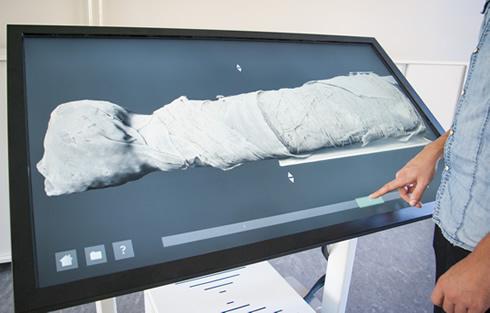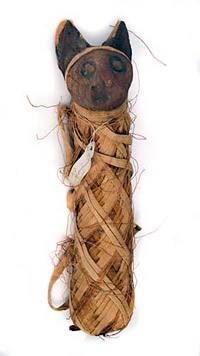Natural History Museum
Source - http://phys.org/news/2012-09-unwrap-mummified-egyptian-catvirtually.html#jCp

The ancient mummified cat's inner secrets are revealed using the digital specimen table called Insider Explorer. Credit: Kristofer Jansson, Interactive Institute
Using a state-of-the-art digital specimen table called Insider Explorer, visitors to the Museum's largest ever science festival will be able to peel away the mummified cat's bandages in ways never before possible.
With a hand swipe across the 55-inch interactive screen, the inner secrets of some of the most intriguing Museum specimens are revealed in ways even Museum scientists have not yet experienced.
The Interactive Institute and Visualization Center C, Sweden, worked together with Museum scientists on this project. David Hughes, manager at the Interactive Institute explains, 'We're thrilled to be partnered with the London Natural History Museum on such a ground-breaking project. The combination of their amazing collection, great science facilities and our pioneering visualisation technology has created something very special.'

Egyptian mummified cat specimen looked after at the Museum. It is about 2,500 years old.
Originally designed for use in forensics and virtual autopsies on humans, at the Centre for Medical Imaging and Visualisation (CMIV) in Sweden, this is the first time the table has been used to explore a natural history collection.
Chris Jones, Museum's Head of Imaging and Analysis Centre (IAC) says, 'This table is an exciting opportunity to take some of our current scientific research directly into the galleries. Outreach is an important element of the Museum's work and the table will offer a unique method for visitors to interact with recent scientific discoveries'.
As well as the mummified cat, visitors will also be able to carve away a block of 20-million-year-old amber to reveal a trapped gecko, and cut away rock to expose pockets of gases in the world-famous Tissint meteorite, the Martian meteorite that fell to Earth just last year.
To get the highly detailed 3D images seen on the table, specimens were scanned using the Museum's micro-CT scanner. The cat mummy scan produced more than 3000 images.
The technology allows large amounts of scientific data to be processed at speed, as Hughes explains. 'The combination of cutting edge hardware and specially developed software algorithms means that the system can deliver an extremely responsive interactive experience even with incredibly large and complex datasets. This is key to deliver a good experience for the user.'
So, unlock your inner scientist and come along to Science Uncovered, and as Hughes concludes, 'experience the same thrill of discovery that scientists do every day in the labs.'